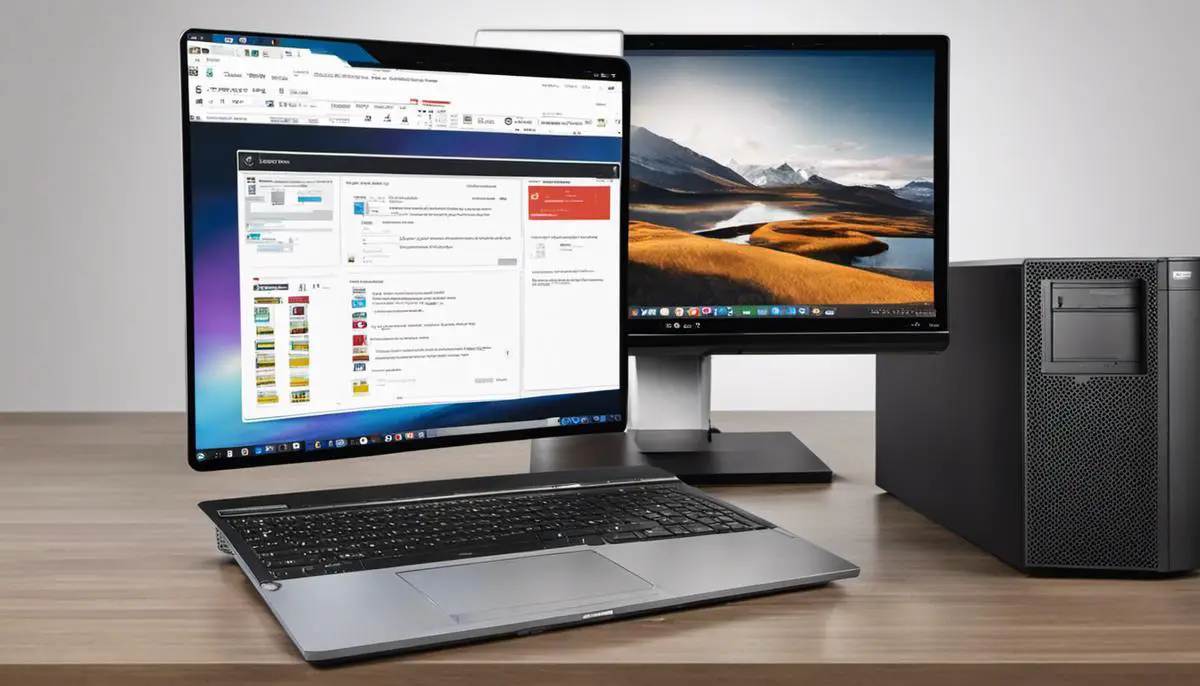In the realm of personal computing, the decision between a laptop and a desktop is a significant one that impacts productivity, convenience, and the overall user experience.
This comprehensive analysis delves into the intrinsic technicalities, trade-offs, and advantages that both options offer.
Designed for the discerning reader, the following exploration presents in-depth insights, providing you with essential information to guide your choice toward an optimal computing experience.
- I. Understanding Your Computing Needs
- II. Comparing Performance, Expandability and Price
- III. Understanding the Basics: Laptop vs Desktop
- IV. Comparative Analysis: Laptop Vs. Desktop
- V. Choosing What Fits Your Needs
- Key Features Comparison
- Laptop vs Desktop: Processing Speed Comparison
- Storage Capacities: Laptop vs Desktop
- Memory: Laptop vs Desktop
- Graphics Capabilities: Laptop vs Desktop
- Display Quality: Laptop vs Desktop
- The decision to choose a laptop or a desktop is heavily influenced by a user’s individual requirements and preferences.
- Price Versus Performance
- Flexibility and Mobility
- Upgradability and Lifespan
In an era where technology is moving at a rapid pace, understanding the essential differences between laptops and desktops becomes increasingly important. This knowledge is crucial whether you’re an enthusiast, a hobbyist, or a casual user. Whether you’re deciding on a purchase or simply aspire to gain deeper insight into these everyday tools, this discourse serves as an enlightening guide.
I. Understanding Your Computing Needs
Understanding your specific computing needs is crucial in making the right choice between a laptop and a desktop. This involves considering several factors:
Purpose: Work, Study, or Leisure
- Work: If your work involves demanding tasks like graphic design or video editing, a desktop might be more suitable due to its superior processing power and larger display.
- Study: Laptops are typically ideal for students due to their portability, allowing for easy transport between classes and study sessions.
- Leisure: For casual web browsing or streaming, both laptops and desktops can suffice. However, serious gaming often requires the superior performance and upgradeability of a desktop.
Mobility: Need for Portability
- High Mobility: If you’re consistently on the move, a laptop’s portability is invaluable. They are designed for on-the-go use, with features like built-in Wi-Fi and battery power.
- Low Mobility: If you primarily work from a single location, a desktop may be more suitable. Desktops generally offer more power and a larger display size at a lower cost.
Space Considerations
- Limited Space: Laptops, with their compact size, are ideal for small workspaces or living areas.
- Ample Space: With more room, you can benefit from the larger display and enhanced performance of a desktop. Just remember, desktop setups also require space for peripherals like a mouse, keyboard, and potentially a printer.
Read: Top Monitors for Graphic Design: A Comprehensive Choice Guide
II. Comparing Performance, Expandability and Price
When considering the choice between a laptop and a desktop, performance, expandability, and price are also determining factors.
Performance:
- Desktop: Desktops typically offer superior performance, with faster processors and more powerful graphics cards. They can handle demanding tasks like video editing, 3D modeling, and high-end gaming more effectively.
- Laptop: While not as powerful as desktops, modern laptops can still handle a wide range of tasks. High-end laptops are now capable of running demanding applications, though they may be more expensive.
Expandability:
- Desktop: One of the significant advantages of a desktop is its expandability. You can easily upgrade your hard drive, add RAM, or swap out your graphics card to improve performance.
- Laptop: Laptops offer limited expandability, usually only allowing for RAM and storage upgrades. Some high-end laptops may not allow for any upgrades at all.
Price:
- Desktop: Desktops often offer more value for money when it comes to raw performance. You can also build a desktop to your exact specifications, potentially saving money in the process.
- Laptop: While laptops may be more expensive for the same level of performance, the price includes portability and often a built-in webcam and microphone for video calls.
Pro Tip: When weighing your options between a desktop and a laptop, consider your primary use-case and location of work. If your computing demands vary significantly, you might want to consider having both. A powerful desktop for heavy-duty tasks and a lightweight laptop or tablet for mobile needs can often be a practical solution. It’s all about finding the balance between performance, portability, and price that best fits your personal or professional requirements.
Also Read: Top 5 Best Lenovo Laptops To Buy
III. Understanding the Basics: Laptop vs Desktop
A fundamental starting point when comparing laptops and desktops is understanding the noticeable physical differences.
- Desktops are large, stationary computers that usually consist of separate pieces that are connected together: the computer itself (often referred to as the “tower”), a monitor, a keyboard, and a mouse.
- On the other hand, laptops are portable devices where all the components – including the screen, keyboard, touchpad, or pointing stick – are part of one compact unit.
Desktop: An Overview
Desktops, due to their larger size, often have more power capacity. They can accommodate larger components, such as full-size graphics cards and multiple hard drives or solid-state drives. They’re typically easier to upgrade because individual components can be replaced or added as needed.
Additionally, since desktops aren’t designed to be portable, can run on direct power from an outlet without worrying about battery life.
Laptop: An Overview
Laptops, with their all-in-one design and lightweight, are designed for mobility. They run on rechargeable batteries, allowing you to use them without being plugged into a power source.
Laptop components are often engineered for efficiency and power-saving to extend battery life. However, due to space limitations, they might not offer the same level of performance compared to desktops.
IV. Comparative Analysis: Laptop Vs. Desktop
In this section, we’ll delve into a comparative analysis of laptops and desktops across various dimensions such as performance, flexibility & upgradeability, cost, and lifespan.
Performance
- Desktop: Owing to the larger form factor, desktops can incorporate more powerful hardware, leading to superior performance. This performance advantage allows desktops to handle demanding tasks like 3D rendering, high-end gaming, and large-scale data processing more efficiently.
- Laptop: Modern laptops have significantly bridged the performance gap. High-end laptops can now run power-hungry applications and multi-task effectively, although at a higher cost compared to a similarly equipped desktop.
Flexibility & Upgradeability
- Desktop: Desktops offer unparalleled flexibility and upgradeability. You can easily upgrade the RAM, storage, processor, and graphics card to extend its life cycle or boost performance. For instance, if you’re a gamer, you can upgrade to a better graphics card to play the latest games.
- Laptop: Laptops have limited upgradeability options. Usually, only the RAM and storage can be upgraded. This means over time, as software requirements increase, your laptop might struggle to keep up. High-end models might not offer any upgrades at all.
Cost
- Desktop: The cost-to-performance ratio of desktops is typically more favorable. You can build a powerful desktop at a lower cost than a high-end laptop. Desktops also allow for customization and upgrading individual components, which can save money in the long run.
- Laptop: Laptops usually cost more for the same level of performance as a desktop. However, this cost also includes the added convenience of portability and typically, a built-in webcam and microphone for video calls.
Lifespan
- Desktop: With the ability to upgrade components and better heat dissipation, desktops tend to have a longer lifespan than laptops. For example, if a part fails or becomes outdated, you can replace it without having to replace the entire system.
- Laptop: Laptops generally have a shorter lifespan due to their compact design. Limited heat dissipation can lead to more wear and tear, and the inability to upgrade most components means when the laptop starts to lag behind, you’ll likely need to replace the whole machine.
See: Ultimate Guide to Choosing the Perfect Laptop for Graphic Design
A Brief History: The Evolution of Laptops and Desktops
Desktop computers have been around longer than laptops. They were the first personal computers to be rolled out to the public, dating back to the early 1970s. The first commercially successful desktop computer was the Apple II, launched in 1977.
Laptops, on the other hand, entered the consumer market in the late 1980s, with models such as the Toshiba T1100. Since their introduction, laptops have evolved from heavy, cumbersome devices to slim, lightweight machines with capabilities and performance that rival or surpass many desktops.
V. Choosing What Fits Your Needs
In this section, we will provide recommendations based on different use cases. Whether you’re a student, a professional, or a gamer, we’ve got some advice to help you make the right choice.
A. Recommendations for Students
Students often require a balance between portability and performance. Laptops, especially lightweight models, are highly recommended. With a laptop, taking notes in class, studying in libraries, and working on group projects becomes significantly easier.
- For instance, a MacBook Air or Dell XPS 13 could be an excellent choice for their lightness, durability, and sufficient processing power for most academic tasks.
B. Recommendations for Professionals
For professionals, the choice between a laptop and a desktop often depends on the nature of the work. If your work involves graphic design, video editing, or other demanding tasks, a high-performance desktop might be more suitable.
- A desktop like the iMac or Dell XPS Desktop would deliver the power you need. However, if you’re a professional always on the move, requiring to work from diverse locations, a high-end laptop like the MacBook Pro or Lenovo Thinkpad X1 Carbon would be ideal because of its portability, robust build, and powerful specifications.
C. Recommendations for Gamers
Gamers might prefer desktops due to their superior performance and upgradability. Desktops allow gamers to play the latest titles at higher settings and frame rates.
- A PC with the latest-generation Intel or AMD processor and a powerful GPU like the Nvidia RTX 3080 would provide a premium gaming experience.
- However, if mobility is a must, gaming laptops like the Alienware Area 51M or ASUS ROG Zephyrus offer high-end gaming performance in a (somewhat) portable package.
Remember, the ideal choice depends on your specific needs and circumstances. While a desktop may offer more power, a laptop provides convenience and portability. Assess your situation, determine your requirements, and make an informed decision that best suits your needs.
Laptop vs Desktop: Which One to Choose?
The debate between selecting a laptop or a desktop is entirely dependent on your unique computing requirements.
- If small size, weight for frequent travel, or space restrictions are essential factors for you, then a laptop clearly fits the bill.
- However, for heavy-duty users who indulge in intensive gaming, video editing, or other demanding tasks, a desktop may prove to be a more appropriate choice, given its improved cooling mechanism and scope for upgradability.
Both options come with their own pros and cons. By understanding these basic differences between laptops versus desktops, you can make a well-informed decision, tailoring it precisely to your specific needs.

Key Features Comparison
Laptop vs Desktop: Processing Speed Comparison
A computer’s processing speed largely hinges on its Central Processing Unit (CPU). Laptops generally have mobile processors, designed to prioritize power efficiency over raw performance.
Such design is aimed at minimizing heat production, subsequently helping laptops stay cool and portable. However, they typically have less processing power compared to desktop CPUs, which is principally defined by the number of cores and clock speed.
Desktop CPUs, on the other hand, focus more on performance over power conservation, and thus, offer higher processing speeds. With superior cooling mechanisms and higher clock speeds, desktops manage to trump laptops in overall performance.
Storage Capacities: Laptop vs Desktop
Storage capacity refers to how much data a computer can store. Generally, desktops offer more storage capacity than laptops.
While laptops commonly provide SSDs (Solid State Drives) that offer lesser storage space (256GB to 1TB), desktops have the option to accommodate multiple hard drives at a time thereby extending storage capacities up to several terabytes. SSDs in laptops, however, have an advantage over HDDs in terms of speed, noise, and durability.
Memory: Laptop vs Desktop
Physical memory or RAM (Random Access Memory) in a computer affects the speed of task executions. Laptops generally come with 8GB to 16GB of RAM, while some high-performance models may offer up to 32 GB.
Desktops, on the other hand, generally start from 8GB and can be expanded to a staggering 128 GB. Hence, when it comes to multitasking and running memory-intensive software, desktops offering higher capacities are the clear winners.
Graphics Capabilities: Laptop vs Desktop
The graphics processing unit (GPU) plays a critical role in rendering images, animations, and videos. Desktops typically have stronger graphics cards which require more space and cooling, things that are attainable due to their larger size.
Laptops, to maintain slim profiles and portability, typically resort to integrated graphics or low-powered discrete GPUs. For hardcore gamers or graphic designers, a desktop with a powerful GPU would be more beneficial.
Display Quality: Laptop vs Desktop
Laptops typically offer resolutions ranging from HD (1366×768) to 4K (3840×2160), with screen sizes between 11-17 inches. The graphical quality in laptops is usually high, but due to smaller screen sizes, the ability to multitask with multiple windows can be limited.
Desktops, on the other hand, don’t come with an inbuilt display. This means you can choose a monitor that fits your needs perfectly — from Full HD to 8K, and with varying screen sizes, refresh rates, and color accuracies.
For professionals requiring color-critical work, a desktop with a high-end monitor is preferable.
The decision to choose a laptop or a desktop is heavily influenced by a user’s individual requirements and preferences.
Although desktops may have an edge in terms of power, upgradeability, and overall performance, laptops are valued for their portability, compact size, and sufficient capability to perform most tasks efficiently.
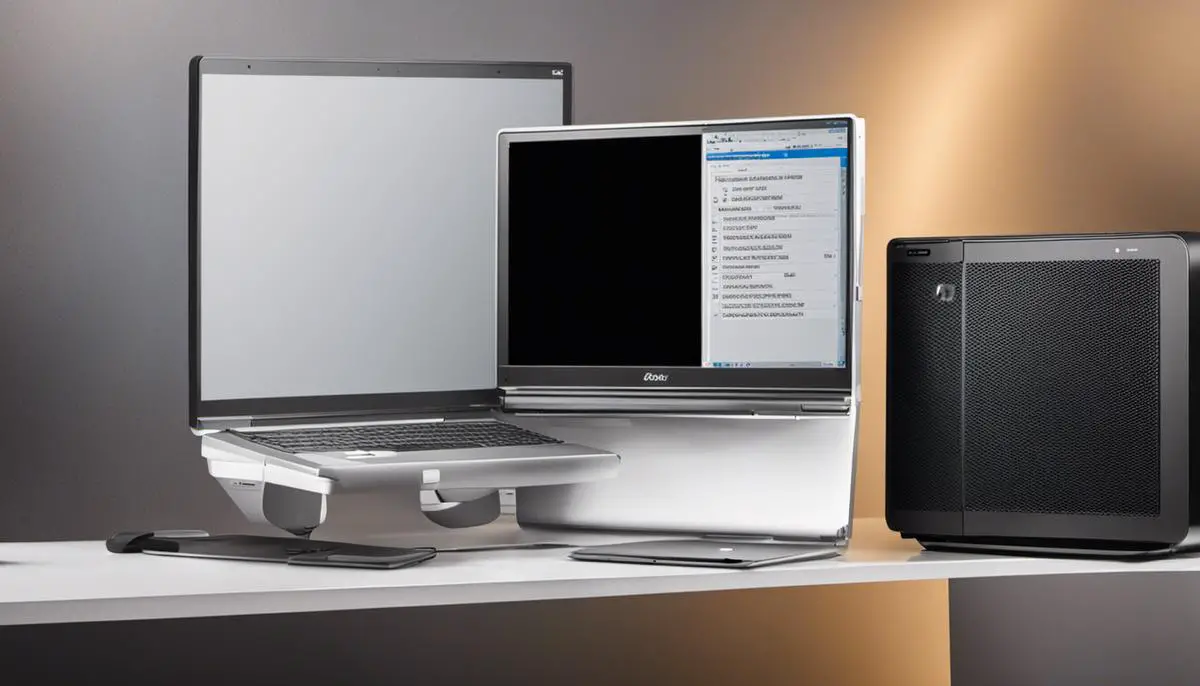
Price Versus Performance
Price Versus Performance: A Comparison Between Laptops and Desktops
Choosing between a laptop and a desktop can be a nuanced decision, with key factors such as price and performance playing influential roles. High-performance computing often comes with a higher price tag. As unit costs vary greatly across types, one must carefully assess their relative value.
Laptops are popular primarily due to their portability. Their sleekness, compactness, and battery operation make them a great tool for on-the-go use.
To enjoy these advantages, however, one often has to pay a premium. Top-notch laptops boasting desktop-like performance can be quite expensive.
Limited performance capabilities owing to their restricted space for heat dissipation can also be a significant downside for laptops.
In contrast, desktops are synonymous with high power and superior upgrade capabilities. With room for larger and more potent components, they are less vulnerable to thermal issues compared to laptops.
The potential lifespan of a desktop, owing to its individual replaceable parts, often surpasses that of a laptop.
Compatibility and accessibility to larger, more robust components allow desktops to offer more power at less cost. Considering this, an equally priced desktop will generally outperform a laptop. If performance is your priority and mobility isn’t a necessity, the desktop seems to be the better choice.
Considering all factors, the choice between a desktop and a laptop will largely depend on personal needs. For lighter, general home use, a laptop can be an ideal fit. However, for tasks demanding higher computational power like video editing or gaming, a desktop might be a more economically viable option.
In summation, laptops offer convenience and mobility but can cost more and offer less power. On the other hand, desktops can provide enhanced power and longevity at a relatively lower cost but compromise on portability. It’s important to make a decision based on personal needs to achieve a perfect balance between cost and performance.
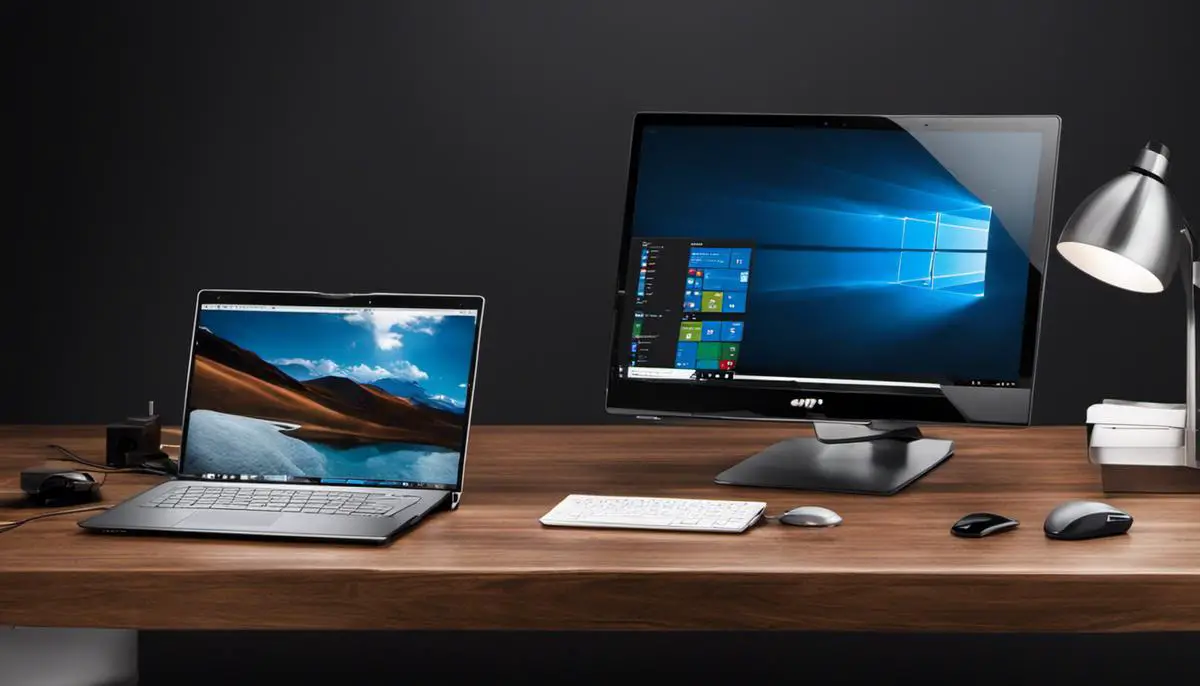
Flexibility and Mobility
Loading Up on Flexibility and Mobility: Laptops Versus Desktops
Pushing the boundaries of mobility, laptops have brought portable computing to new heights. A laptop empowers you to accomplish various tasks from different locations. Whether it’s preparing a report at a cafe, or catching up on your favorite show in bed, laptops provide a feature-packed all-in-one solution.
Laptops’ versatility extends beyond the office, transforming educational settings and even competitive gaming arenas. With their lightweight, compact size, and independent power supply, laptops score high on flexibility. It is these unique attributes that make laptops superior in mobile computing.
However, the quest for mobility can sometimes compromise other critical aspects of a laptop. Notably, hardware capabilities often take a hit to accommodate the requirements of a compact design. The need for smaller, thinner components limits their power and flexibility compared to desktop counterparts. While it’s true that mobility gives laptops an edge in certain scenarios, in sheer performance and customizable flexibility, desktops usually maintain the upper hand.
Desktops: Stability and Power
Desktops, on the other hand, while lacking in mobility, make up for it with their adaptability, power, and stability. They can be easily upgraded with high-end components, often resulting in higher performance compared to laptops. This becomes especially relevant for professions like graphic designing, video editing, and gaming where higher processing power, a bigger display, and better graphics are required.
Additionally, with desktop computers, a variety of hardware options are available allowing for customization based on your specific needs. If a component fails or becomes obsolete on a desktop, it can be replaced without much hassle. This element of flexibility isn’t easily achieved with laptops.
While desktops inhibit movement due to their bulk and requirement for a constant power supply, stability in a static work or gaming environment suits many. The advantage of desktops shines in places where mobility isn’t a requirement but where power, robustness, and adaptability are given precedence. With that said, desktop-based workstations or gaming setups also have the potential to be more ergonomic, disregarding some drawbacks such as the space they consume.
Conclusion: Laptop vs. Desktop
When it comes down to deciding on a laptop or a desktop, the choice is essentially about an individual’s personal preferences and computing needs. If you value portability and versatility, a laptop will serve your needs admirably. However, when the focus is on access to robust processing power—particularly for tasks that demand a lot of it—a desktop is undeniably the best choice.
Don’t think of it so much as a choice between two devices, but rather about identifying the tool that best aligns with your unique computing necessities. Laptops shine in scenarios where flexibility and on-the-go access are paramount, while the strengths of desktops lie in delivering superior performance, customization options, and stability where it counts.
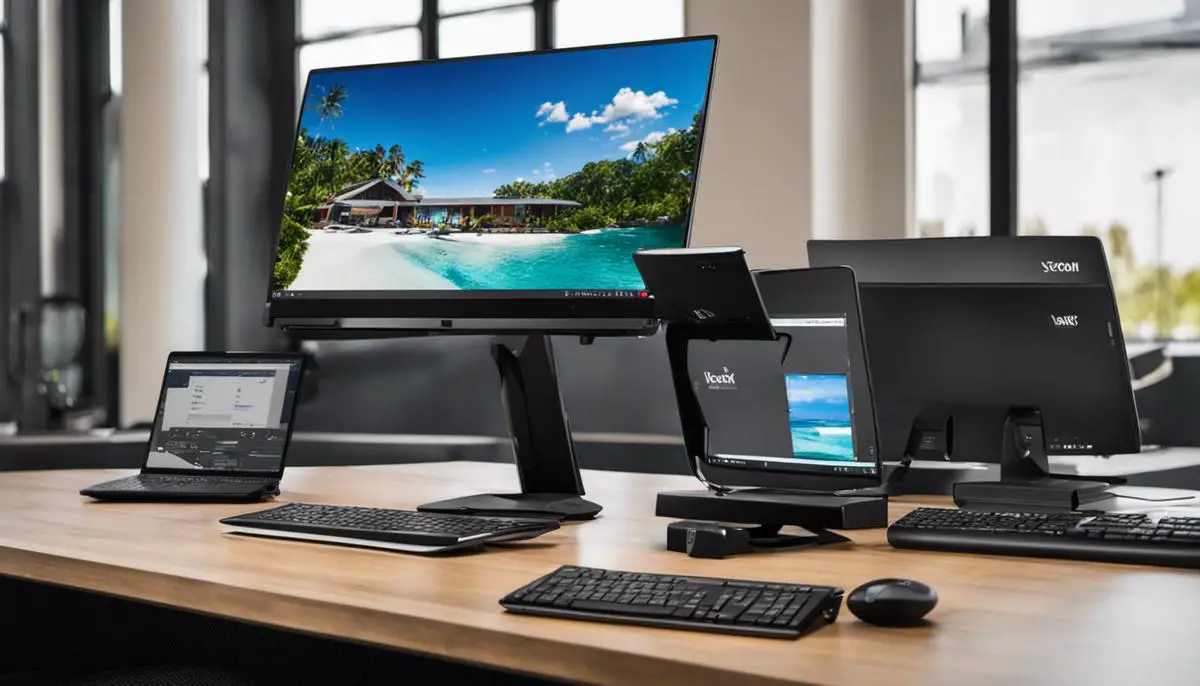
Upgradability and Lifespan
Upgradability of Desktop Computers
Offering an extent of upgradability that laptops simply can’t match, desktop computers are something of a tinkerer’s dream. Desktops are constructed with large and interchangeable components, meaning as technology progresses or existing parts start to show their age, they can be conveniently replaced.
Even with limited technical expertise, it’s usually possible to upgrade your desktop components, be it the central processing unit (CPU), the graphics processing unit (GPU), random access memory (RAM), power supply, or hard drives.
Thanks to their roomy cases with multiple slots for additional drives and expansion cards, desktops offer a significant advantage when it comes to customization and future-proofing your hardware.
While upgrading desktop components offers plenty of upsides, you should be aware of the potential pitfalls. It requires a basic understanding of the PC’s internals and mindful handling of the delicate components.
Also, keep in mind that the cost of the components can be quite a variable, largely dependent on the power of the part and how new it is. Essential pieces like high-end CPUs and GPUs can carry a hefty price tag. However, a careful selection process or considering used parts could make your upgrade more affordable.
Upgradability of Laptop Computers
In contrast, laptop upgradability is generally limited. Laptops are designed for portability and compactness, which often means that components are soldered directly onto their motherboards in an effort to save space.
The most commonly upgradeable parts are RAM and hard drives (solid-state or hard disk drives). Yet, these are only replaceable in some laptops.
Upgrades can also be complex and require a high level of technical knowledge to avoid damaging the system.
Furthermore, the smaller and more specialized components that laptops use tend to be pricier to upgrade than those for desktops. Laptops are best purchased with future needs in mind, because upgrading may not be a feasible option down the line.
Lifespan of Desktop and Laptop Computers
The lifespan of a computer depends significantly on its build quality, usage, and maintenance. Desktops typically have a longer lifespan, easily lasting 5-8 years. Replacing or upgrading faulty or outdated parts can further extend this lifespan, sometimes up to a decade or more.
Laptops, on the other hand, generally have a shorter lifespan of around 3-5 years. Their compact design not only makes them susceptible to overheating but also means that worn-out components are harder to replace.
However, careful use, regular maintenance, and cleaning can ensure a laptop reaches or exceeds its potential lifespan.
Cost and Complexity of Component Upgrade
The cost of upgrading a desktop computer can vary drastically. If you opt for state-of-the-art components, the price can run high. However, budget-friendly and second-hand options exist that can make the process more economical, albeit at the expense of performance.
In comparison, the cost and complexity often associated with upgrading laptop components can be a major deterrent.
Not all laptops offer the same level of upgradability, and even when they do, the components can be pricey and their installation complex. Therefore, when purchasing a laptop, it’s advised to consider future needs and opt for a model that already includes higher specifications to delay the necessity for an upgrade.
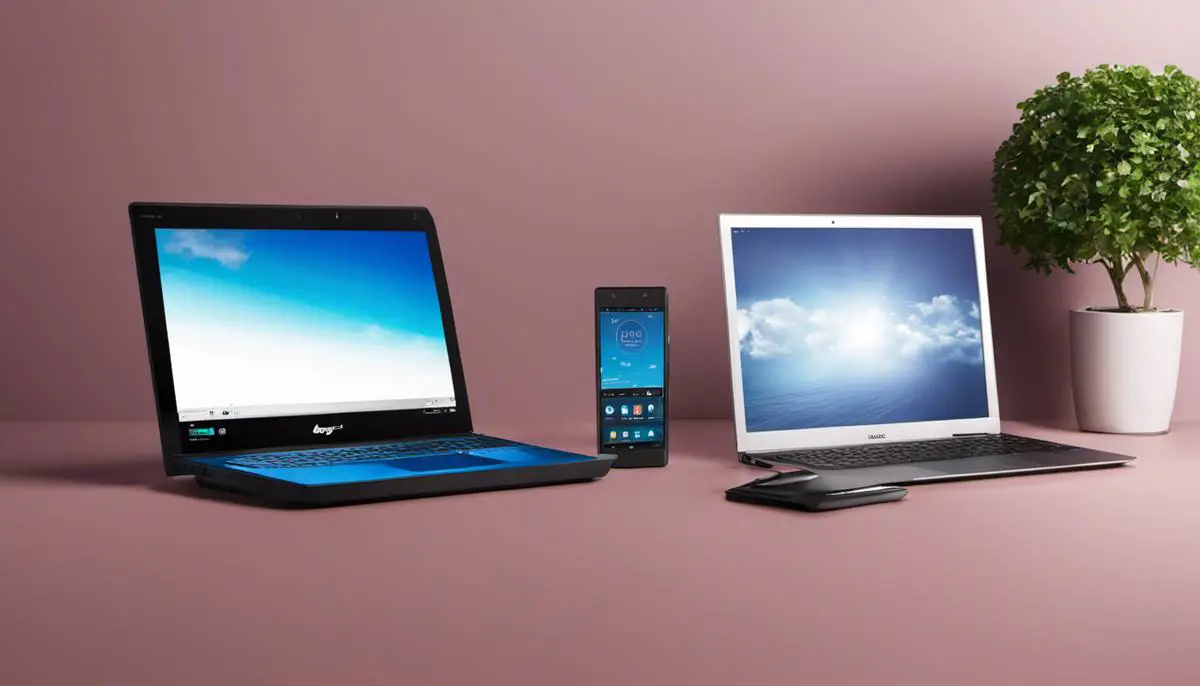
The choice between a laptop and a desktop goes beyond surface-level factors such as price and appearance. It delves deeper into aspects like performance, flexibility, and the potential for future upgrades.
Not only are these considerations pivotal in understanding the value you’re getting for your money, but they also influence how well the machine caters to your individual needs, preferences, and lifestyle.
By unpacking these elements, we provide a holistic picture of the debate to empower you in your decision-making process.
Ultimately, whether for professional use, gaming, studying, or just browsing, mastering the complexities and strengths of these machines proves valuable and enlightening. The journey of exploring, comparing, and understanding is a rewarding one, and the knowledge you’ve gained may serve you well beyond the confines of this discussion.

J.S. is the owner, content creator, and editor at Upgrades-and-Options.com. I’ve worked in the IT and Computer Support field for over 20 years. The server hardware in my computer labs has mostly been IBM, but I’ve supported Dell, HP, and various other hardware. In addition, as part of my lab administrator responsibilities, I’ve learned, supported, and repaired/upgraded network hardware such as Cisco routers and switches. READ FULL BIO >>
- Best Laptops for AI and Machine Learning
- Upgrading SSD Storage in the ThinkPad X9-15 Gen 1 Aura Edition
- How Quantum Computing Could Impact Everyday Laptops
- What Is The Difference Between Lenovo’s Pens? (with Part Numbers)
- Legion 5 Laptop Upgrade Guide: Game Like a Pro
- How to Replace Your Laptop Battery: A Step-by-Step Guide
- IdeaPad Gaming 3 Upgrade (Full Specs)
- Shut Down a Lenovo Laptop: Quick and Easy

